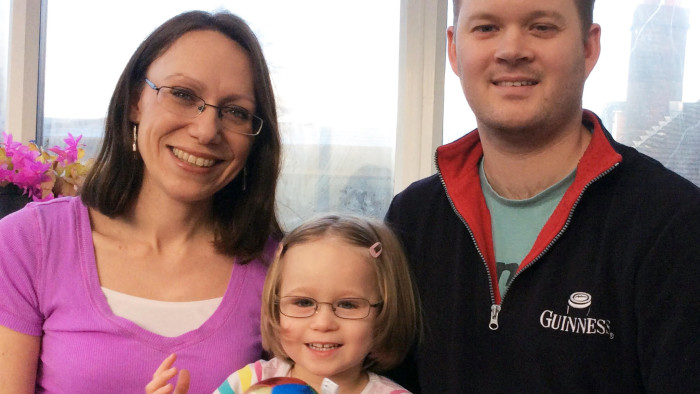Genomics promises a leap forward for rare disease diagnosis

Simply sign up to the Pharmaceuticals sector myFT Digest -- delivered directly to your inbox.
Kate Palmer and Simon Wright were in despair. Their four-year-old daughter Jessica was suffering from epilepsy, poorly co-ordinated movement and slow mental development but doctors had been unable to pinpoint the rare disorder causing these problems. A series of tests including MRI scans, electroencephalography (EEG) recordings and lumber punctures had failed to provide diagnostic clues.
Then they enlisted Jessica in the UK government’s new 100,000 Genomes Project, through Great Ormond Street Hospital in London. By analysing Jessica’s genome — the 3bn biochemical letters of genetic code that control every cell in the body — and comparing it with her parents’ DNA, researchers identified the likely cause of her condition.
A mutation in a gene called SLC2A1 was starving her brain of the sugar needed for efficient metabolism. Although the condition is extremely rare, affecting about 500 people worldwide, clinicians have developed a treatment in the form of a diet that enables the brain to maximise glucose production.
Jessica’s case is an illustration of the way genomics is opening a scientific window on to the vast and mysterious world of rare diseases. Only now is DNA sequencing becoming fast and cheap enough — and bioinformatic analysis powerful enough — to pick out the devastating impact of tiny genetic changes on the health of some.
“Our ability to understand rare genetic diseases is accelerating at an incredible rate,” says Alastair Kent of Genetic Alliance UK, a charity representing 180 patient organisations. “The pace of change is unprecedented.”
In Europe, a disease is classified as rare when it affects fewer than one person per 2,000 in the general population. Around 7,000 rare diseases have been described formally in medical literature, with five new diseases added every week. Collectively they have a big impact on public health, affecting an estimated 5 per cent of the global population at some point in their lives. Three quarters of rare diseases make themselves felt first during childhood.
The genomic approach is promising because 80 per cent of rare diseases have a genetic component. The 100,000 Genomes Project divides its resources between rare diseases and cancer. In the rare diseases arm of the project, 16,150 people including patients and their parents or other close relations have had their DNA read since 2015.
“We have returned reports to around 1,300 families,” says Professor Mark Caulfield, chief scientist at Genomics England, the state-owned company that runs the project.
Between 20-25 per cent of the reports include “potentially actionable” diagnoses — the kind patients could use to ameliorate a condition, not necessarily with drugs but perhaps through physical or psychological therapy or a lifestyle change like Jessica’s diet. “Diagnosis may permit intervention at a younger age,” says Mr Kent. “In cases of intellectual disability, it can make a big difference to do something when the brain is more ‘plastic’ and adaptable.”
Even when a remedy is not available, diagnosis can be a relief. “Families who have been moving backward and forward within the National Health Service looking for answers, often for years, just want to know the cause of the problem,” says Prof Caulfield. “Getting a genomic answer is an enormous leap forward, even if there is no treatment today.”
For parents, knowing the source of the genetic fault may be crucial. If a new mutation has arisen spontaneously in their child after conception, as in Jessica’s case, they do not have to worry about passing it on to future children. If it has been inherited from one or both parents, they can undergo IVF treatment with testing to ensure implanted embryos are free of harmful mutation.
While the majority of participants in the project are likely to find that no useful diagnosis emerges from their genomic testing, that is not necessarily the end of the road. “If we don’t find anything, we will not stop searching,” says Prof Caulfield. “We’ll ask experts in our research partnerships to continue looking for the cause.”
More than 2,000 scientists worldwide have signed up to analyse data from the 100,000 Genomes Project.
Other countries have started similar genomics initiatives, aiming to find the causes of rare diseases. But the UK’s 100,000 Genomes Project stands out not only for the scale of its DNA analysis but also for the way it is integrated with the NHS, Prof Caulfield says.
“The others tend to be freestanding research systems but we aim to transform the way the health service diagnoses and treats rare diseases.”
Meanwhile, at Great Ormond Street Hospital, Maria Bitner-Glindzicz, the consultant looking after Jessica, is delighted with her progress. After a month on the new diet, Jessica’s parents “noticed a big increase in her speech, energy levels and general steadiness,” she says. “Overall she is better and brighter in herself and her parents don’t worry about her having fits on a daily basis as they used to.”
The picture in this article has been corrected. An earlier version of showed a different participant in the 100,000 Genomes Project, Georgia, and her family.
Comments